2016 ohio state
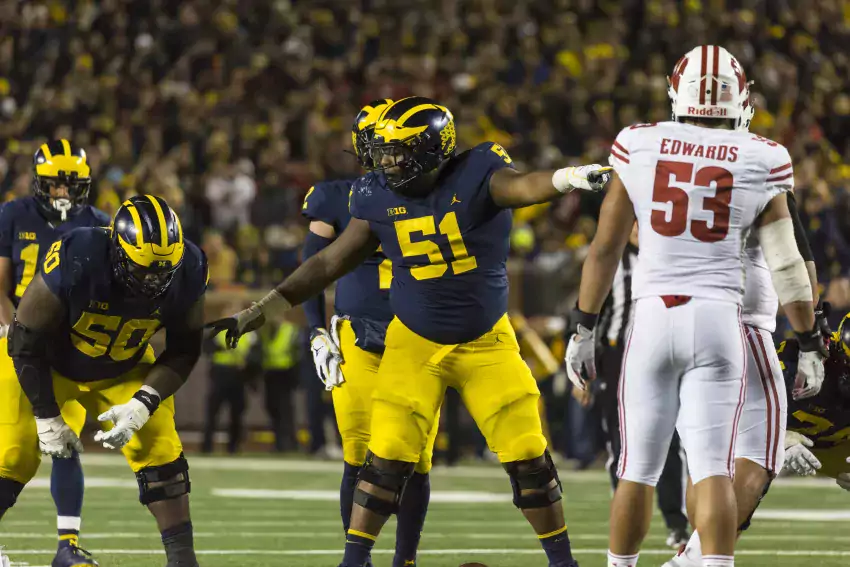
Previously in this series covering the 2010s: Favorite Blocks, QB-RB-WR, TE-FB-OL, Defensive Line, Linebacker, Secondary, Worst Calls, and Dumbest Plays so might as well do the flipside.
This post has a sponsor. Speaking of smart plays, if you’re lookin for a gift to celebrate dads or grads, Michigan Stadium Products makes stuff out of the original Michigan Stadium bench seats and Crisler Arena playing surface, like a pen with a COA signed by Cazzie Russell. MGoBlog readers enjoy a 10% discount on all purchases by using code DADGRAD20 through 6/15.
Take a closer look at the Victors Edition Stadium pen, Stadium cuff links, Cazzie Edition Crisler pen, Crisler bottle opener (almost sold out!), and Michigan Stadium bracelet. Order in time for Father's Day and graduation gifts!
10. Martin and Van Bergen, Coaches at Large
2012 SUGAR BOWL
Football hmmm… [Eric Upchurch]
The press got word after the 2011 Ohio State game that senior DTs Ryan Van Bergen and Mike Martin had been given the green light by their coaches to make the line calls for each play, including when and how to stunt. That in itself wasn’t highly remarkable; the modern Michigan equivalent of RVB’s position, the Anchor, makes line calls for the defense today. The reason it goes down in the lore of these guys is they got so good at it.
They were also the two who lined up and dove into the A gaps to stop VT’s hurry-up 4th and 1 sneak, called the slant that got Frank Clark in to intercept a screen pass, and the slant that got Jake Ryan inside the tackle then chasing inside out on the ensuing rollouts. RVB was doing it on a broken foot too.
-Seth
[After THE JUMP: Glasgows be here]
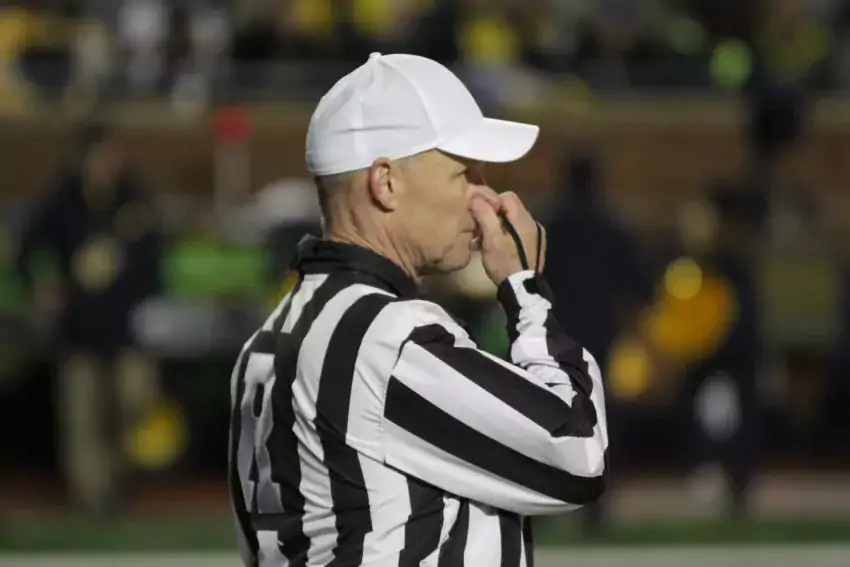
Previously in this series covering the 2010s: Worst Calls of the 2000s, Favorite Blocks, QB-RB-WR, TE-FB-OL, Defensive Line, Linebacker, Secondary
We've put these in two sections for balance: five calls that went in favor of Michigan and calls against Michigan. Calls are being judged 75% on the level of ref boner, and 25% on situational relevance (e.g. if the most insanely bad call in history is overturned on review that gets a 7.5/10—also this happened).
Specifically Omitted Non-Errors
The Spot. Unknowable: this was an impossible call that was bound to stick with whatever was called on the field, and what was called on the field could have been anything. Yes, karmically in the context of that game and cosmically for what it did to Harbaugh's program, The Spot is emblematic of factors outside of Michigan's control having an outsized effect on how we all feel today. It's also a coin-flip that the most competent line judge in the world would call that a first down. Complaining about The Spot is a bad look.
Canny Doale. Danny Coale's overturned completion in the Sugar Bowl is also left off the list. Here again is a call that infuriates the people at the business end of it because of the karma built up at that point by other calls. Also because the announcers didn't know the catch rule, which is a weird rule. VT fans stick around: you absolutely got screwed in this game.
It Wasn't the Refs. Calling the 2011 WMU game early because of weather does not make the list because that was an agreement between Michigan's and WMU's athletic directors, not the officials.
Correct. It was pointed out to me that Penn State fans are mad about the offsides on PSU's successful onside kick in the Coach Failtacular of 2014. I watched it again three times to be sure but it's not even close: he was offsides. Also not offsides: the final stuff of 2015 Minnesota, which complaint warrants mention only because it's why I named our segments with Steve Lorenz "Inside the Crooked Blue Line."
In Which Making the Incorrect Call Was Absolutely the Correct Call (2016 Rutgers)
You’re Rutgers, it's 57-0, Michigan is well into your territory again, and the only thing their fans haven’t gotten yet for their price of admission is to see the cannons fire. Since the offense responsible for giving the artillerymen cause has yet to record a first down, the chances of that aren’t great. Now, as they chant “Fire the can-non” the cannoneers' pride is the only hope of yours.
The third stringer’s in—the onetime “five-star” recruit everybody knows they’re planning to ship off to some directional MAC school. He got to throw a block last play, because everybody’s getting a career highlight at your expense tonight. The scrub now drops back to throw. There isn’t even play-action, is how little they respect you. But it’s low. There’s some commotion—pass interference? probably a pass interference flag—no, the ball’s ricocheted into the air. It’s going to be caught! OMIGOD that’s Deonte Roberts! Your GUY! He’s going to SCORE! TOUCHDOWN RUTGERS! FIRE THE CANNON!
BOOM!
Oh man, you gotta see the replay of that! It’s….oh, that bounced right of the turf. But it was right in front of that ref and he didn’t signal incomplete, so maybe he’s a competent human being who saw something you didn’t. And just like that…
it’s gone. Michigan then scores with a walk-on fullback. It's a great play by that guy. Probably a career highlight.
[After THE JUMP: Five times Michigan was bailed out, and otherwise.]
A few years ago it was de rigueur on this site to talk about how college rules allowed NCAA teams to use a different style of punting, and that this style (called spread or shield) of punting was demonstrably superior to NFL-style (tornado). Michigan has swung between them in recent years. Carr tested out something like shield punting in 2003 then scrapped it when it cost him a game against Iowa. Rodriguez took us to spread punting along with spread offense, and Hoke returned the program to pro-style as was his wont.
In 2015 Harbaugh brought in special teams guru John Baxter and the spread was once again installed, presumably for good. Then Baxter left, and this year Michigan used both. At first we wondered if this was, like under Hoke, some relic of a coaching staff that strove to be pro-like in everything. But as the punt blocks, and near punt blocks, and running-intos that by all rights should have been punt blocks piled up, a new thought emerged: maybe Michigan thinks they’ve solved the spread punt.
Shield punting refresher
For a full explanation of spread punting and a comparison to NFL-style see my 2014 article or watch the Joe Daniel Youtube. Here’s a graphic:
The splits are huge: two yards between the snapper and the guards, and two more yards until the next guy. You don’t care who comes up the A gaps—the only thing the guys on the line of scrimmage have to do is redirect the man lined up outside of them then get downfield (you don’t want your snapper involved in blocking).
The three guys standing about 7 yards back are the “shield”. You want big burly dudes for your shield, and you tell them the Grand Canyon is just behind their heels so they’d better not give an inch. By not giving an inch, they create an eye in the middle of the storm for the punter to safely get the punt off.
Everyone else just has to force the attackers to widen to the point where they can’t get back inside in time to affect the punt. That’s why the guards split so far apart: anyone going outside of them should presumably be too far outside to affect the punt. Anyone coming up the middle will get stuck behind an immovable wall of beef.
In the linked video, Daniel mentions the way to attack it is put four guys into those big “A” gaps, because that could overwhelm the shield. The way the shield would deal with this is block out man-to-man, and let the guys in the A gaps try to get around the shield. As long as your three-man shield can still stop four A-gap rushers, you’ve got a sound punt blocking strategy with two to four more guys releasing downfield than you would in an NFL-style punt.
So…
[After the JUMP we get around the shield]
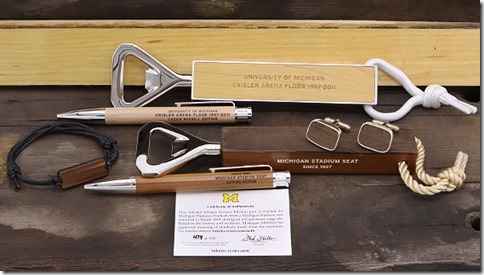
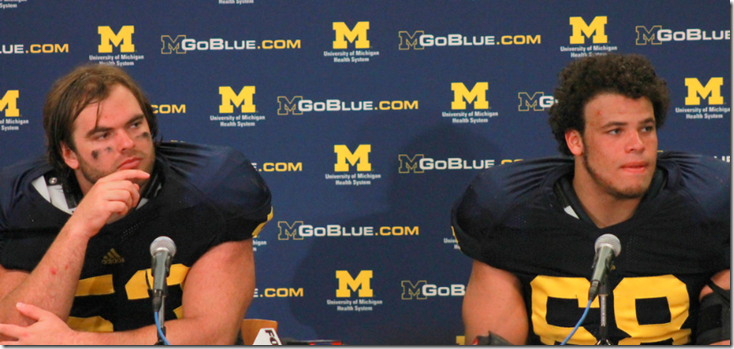
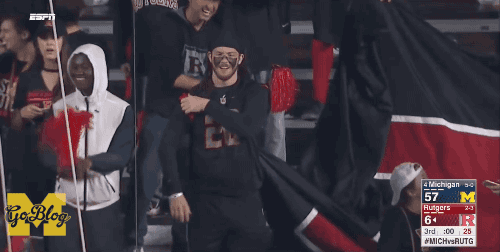
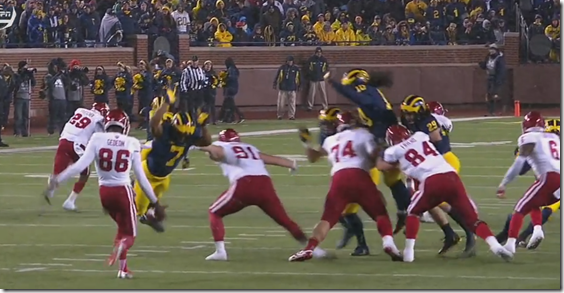

15